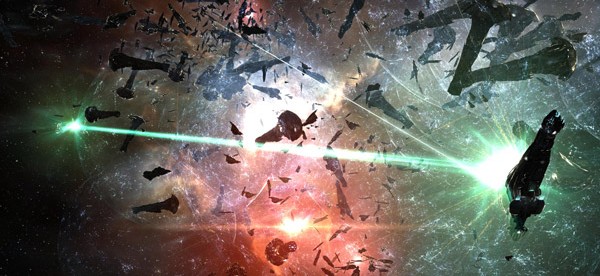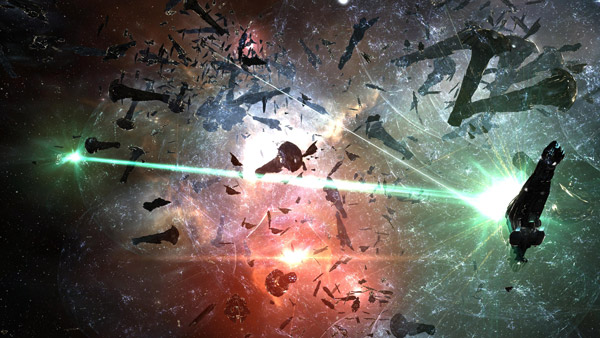The Real Cost of Fake War

In war, things blow up — ships, airplanes, buildings, etc. — and those things cost money. When we typically think of the cost of war, we’re thinking about the human life lost, but even in situations where there aren’t a lot of casualties, the tangible cost is high. In an online war game, though, that’s not the case. All the stuff is virtual — just files on some server somewhere — and if it gets destroyed, the actual “damage” is similar to deleting an email, which is to say, zero (the content of which notwithstanding).
But sometimes, the rules of the game change that.
The Bloodbath of B-R5RB never happened, at least not to those of us who aren’t familiar with the world of EVE Online. EVE Online is an MMORPG — a “massively multiplayer online role-playing game” — which has been around since 2003. The game takes place in space — well, once you log in — and players control fleets. Those fleets are made up of warships, in many cases, because if you’re playing EVE Online, you’re engaged in a universal, 24/7 war.
In some sense, that’s true for a lot of MMORPGs. One of the things that makes EVE a little different, though, is something called ISK — InterStellar Kredits — the in-universe currency in EVE. You can’t buy or sell ISK for real-world money, at least not directly. But you can — and players often do — buy something called PLEX for real cash, and then trade PLEX for ISK. (There’s actually another step in that process and, in general, the gameplay of EVE Online is rather complex. If you really want to dive into it without playing, there’s a Wikipedia page on the topic.) While you can’t sell your warships and the like for real money, at least not without running afoul of the game’s terms of service, you can effectively buy items using, say, U.S. dollars — you just need to go through a currency exchange or two first. As a result — and this is the important part — it’s rather easy to measure the cost of different ships in real-world dollars.
And that makes the Bloodbath of B-R5RB significant to us outsiders.
If you were an active EVE Online player from October 2013 through January 2014, you lived through the following events. Two of the major coalitions in the game, known as CFC and the Russian coalitions (the latter having nothing, probably, to do with the real Russia) were engaged in a war with an alliance of two other coalitions, N3 and Pandemic Legion. One area of space, known as B-R5RB, was under the control of a N3/PL player and under the protection of CONCORD, the in-game security service run by EVE Online itself. As long as the player paid his security bill to CONCORD, the B-R5RB region was virtually immune to attack from CFC/Rus. And as CONCORD was run by the game itself and not a player-controlled service, B-R5RB was as safe as anywhere in the EVE Online universe.
But on January 27, 2014, something went wrong. No one is sure why — N3/PL claims that the game glitched, which seems unlikely — but whatever the cause, the outcome was clear: the player who controlled B-R5RB failed to pay his CONCORD dues. Before N3/PL could reinforce the area and before the player could get CONCORD back up and running, CFC/Rus took notice of the opportunity. Over the next 21 hours, more than 7,500 players battled fiercely for the region of virtual space. Here’s a screenshot from the battle from the official EVE Online recap of the Bloodbath, to give you a sense of the chaos and carnage:

The damage toll was, as expected, immense. Almost 4,000 different ships were destroyed during the engagement, many of which were as large as EVE Online ships come. The two sides fired their doomsday weapons a total of 775 times, which doesn’t mean anything to us lay people, but that’s a lot; according to the EVE website, that constituted “about 24% of all the doomsdays fired in the [prior] two years inclusive.” (And the weapons aren’t called “doomsdays” for nothing.)
Big deal? Just a bunch of 1s and 0s? Yes, all of this took place on the screens and hard drives of computers, not in the real world. But remember that whole ISK and PLEX thing? Keeping in mind that the players used real money to acquire their ships — not directly, but close enough — we can put a real cost on the carnage of this fake war. And that’s exactly what EVE Online did. The estimated total cost of those 4,000 or so ships sat at between $300,000 to $350,000 — easily the most expensive virtual war that we know about.
Bonus fact: EVE Online has been around for more than a decade and, as clearly seen above, the economy is a complex one — arguably as complex as some real-world nations. That requires some sort of oversight, and in this case, it means something akin to the Federal Reserve. As IGN reported in 2013, “EVE’s economy is so rich that CCP [the game’s publisher] actually employs five full-time economists to keep things in balance and make sure that nothing is being done to abuse the systems set in place .”
From the Archives: How a Virtual Plague Helped Epidemiologists Save Lives in the Real World: The title summarizes it well. (It’s World of Warcraft, not EVE, though.)
Related: Ready Player One, an absolutely fantastic book that is kind of about a massive virtual universe. Well, part of it takes place in one. 4.6 stars on average across more than 10,000 reviews, and I’ll toss in a 5-star review of my own, because I really loved the book.
